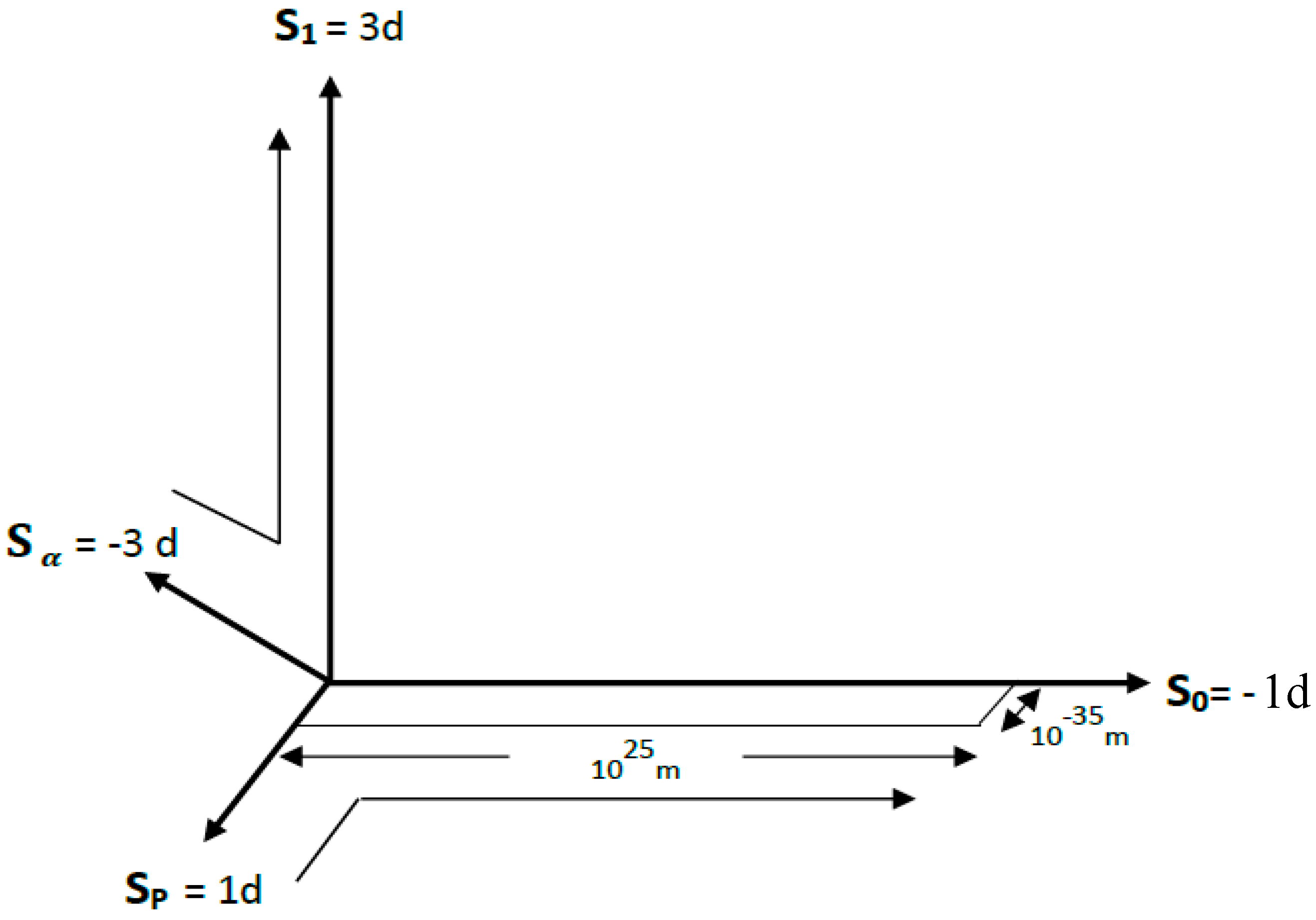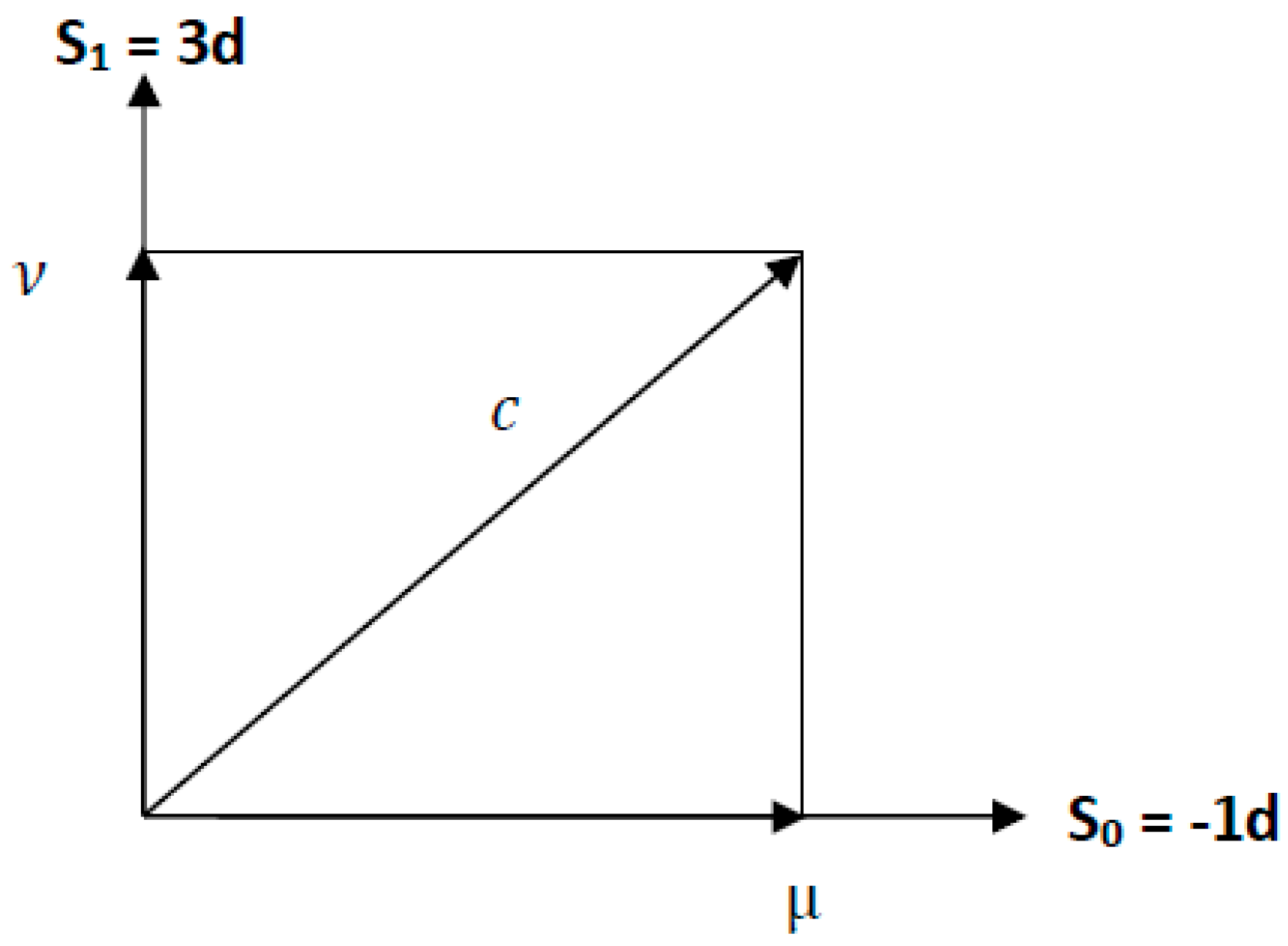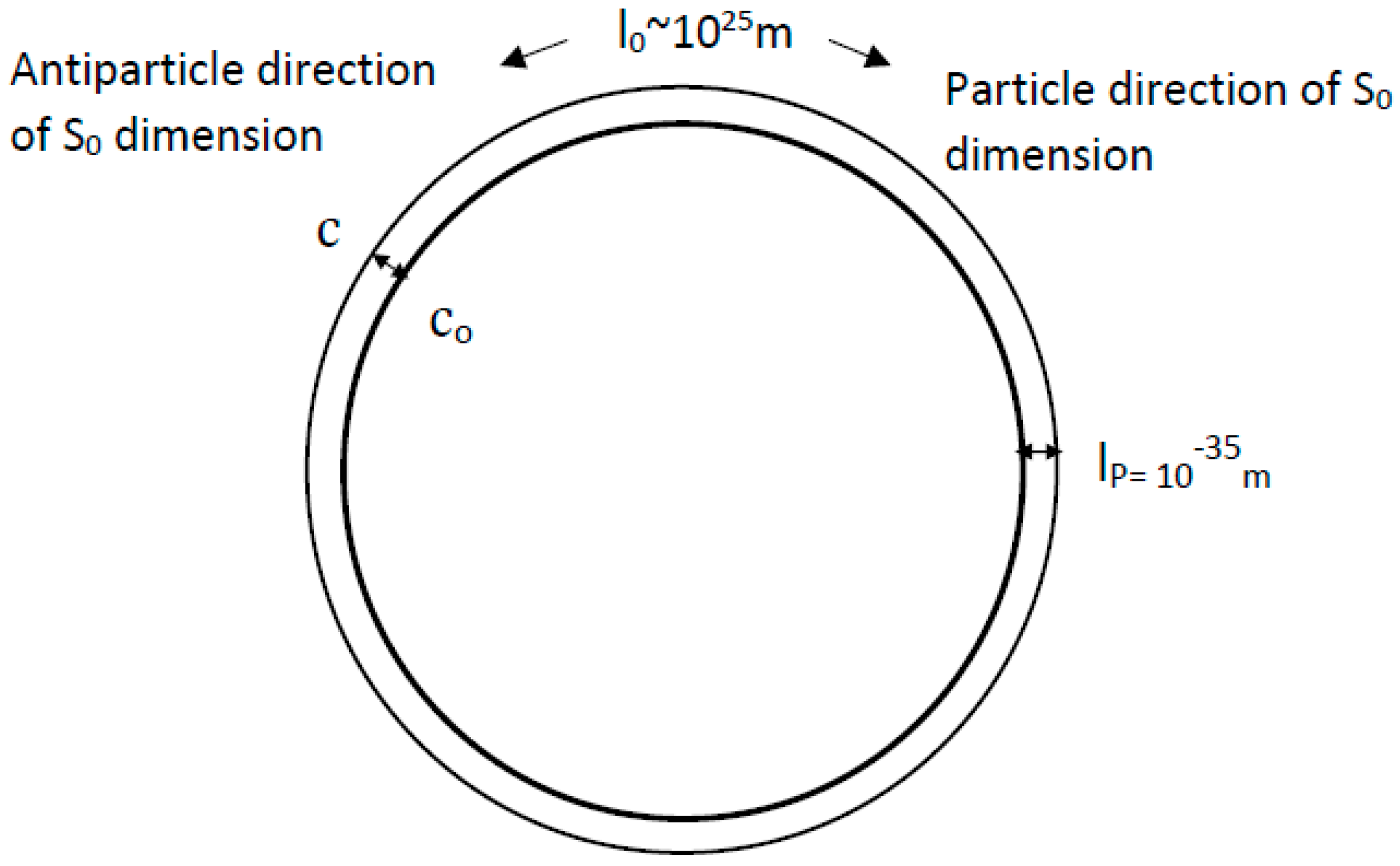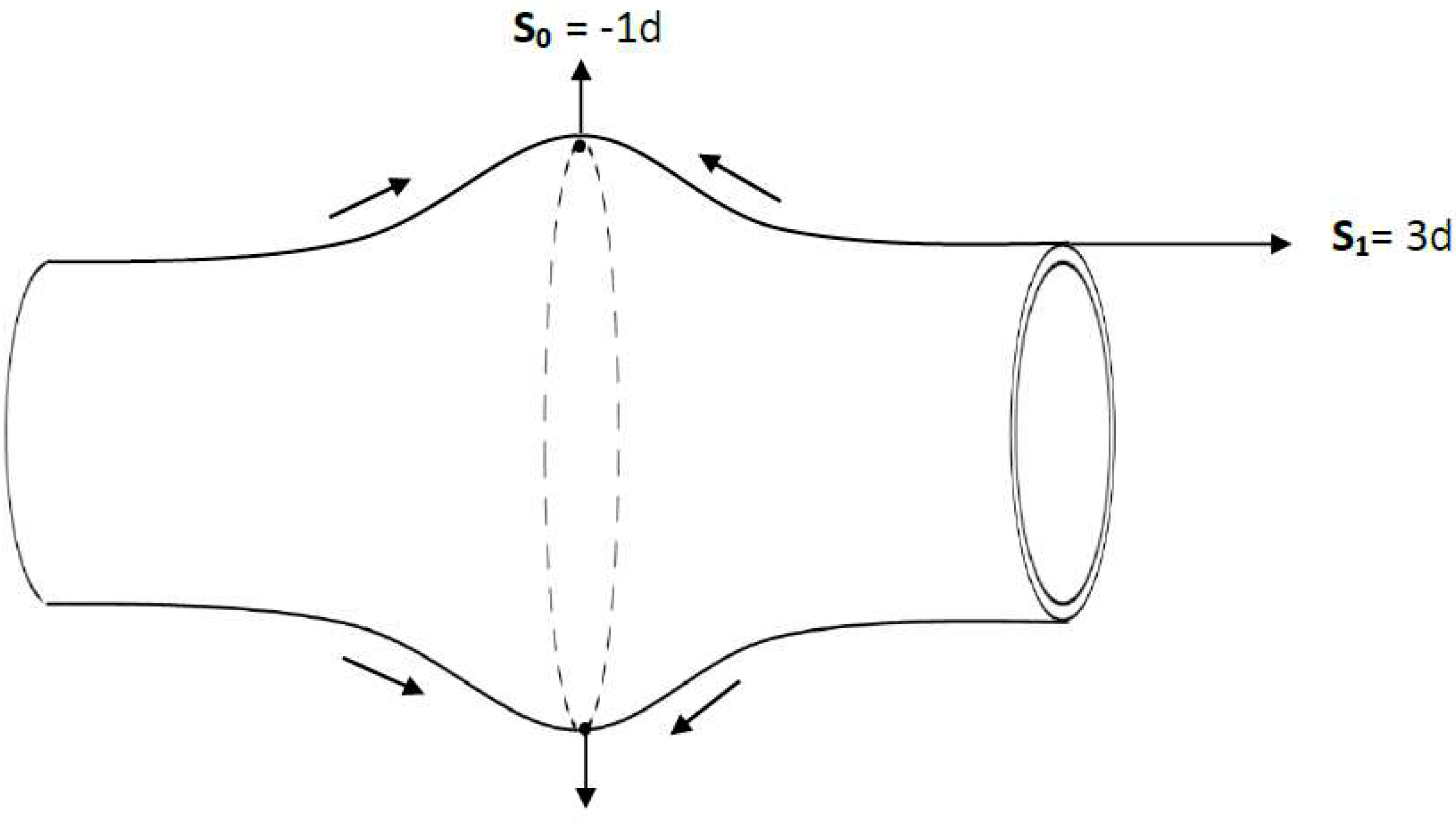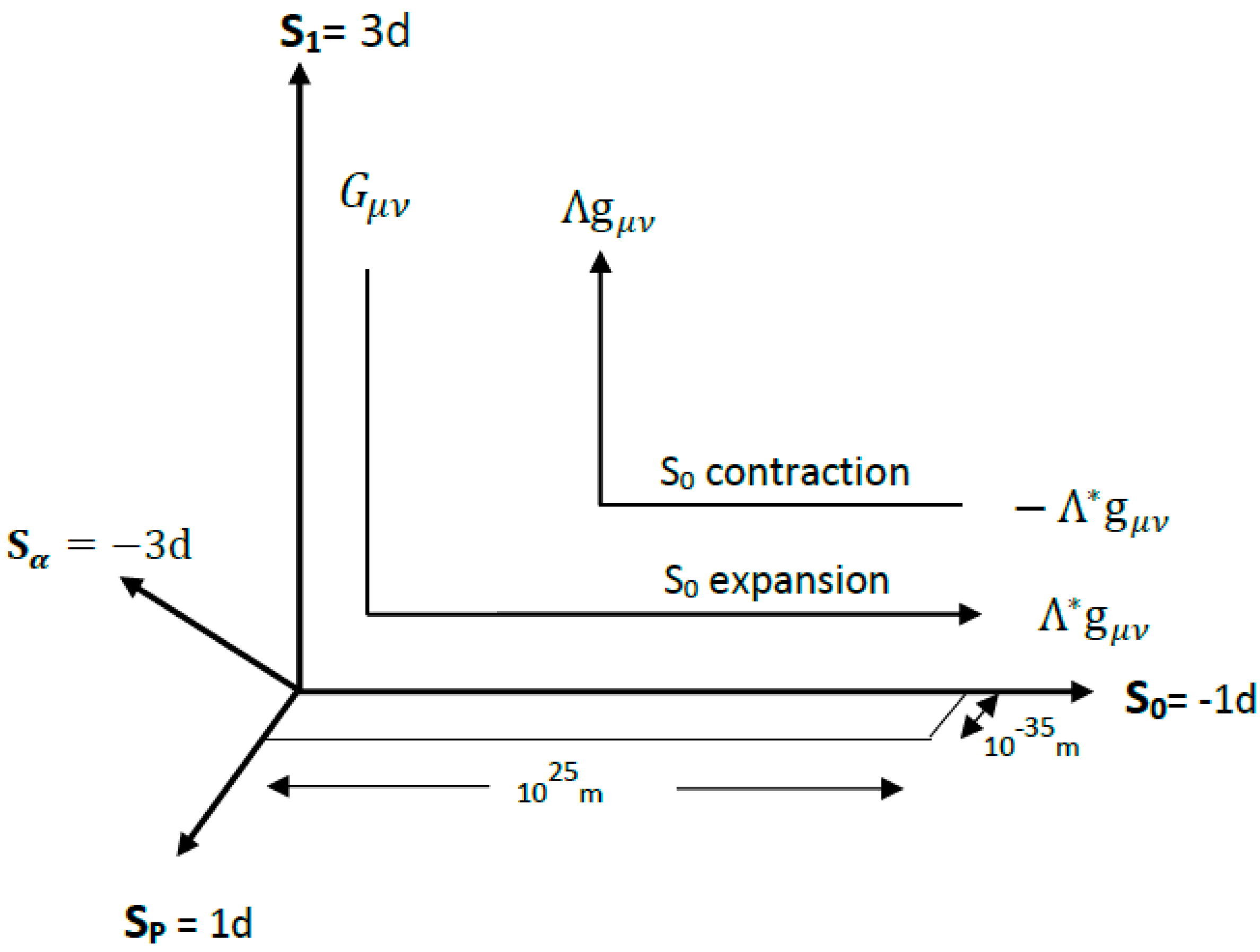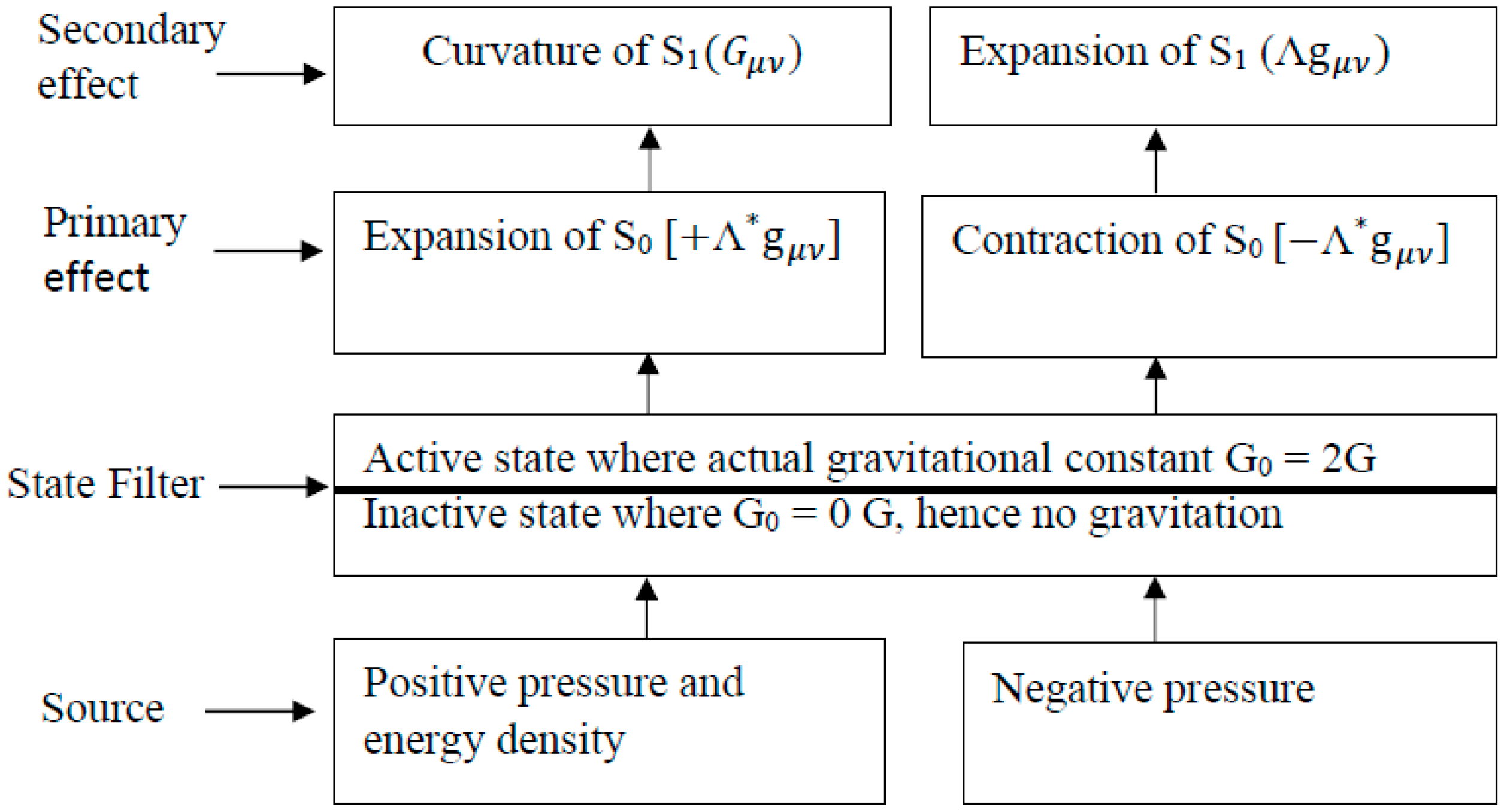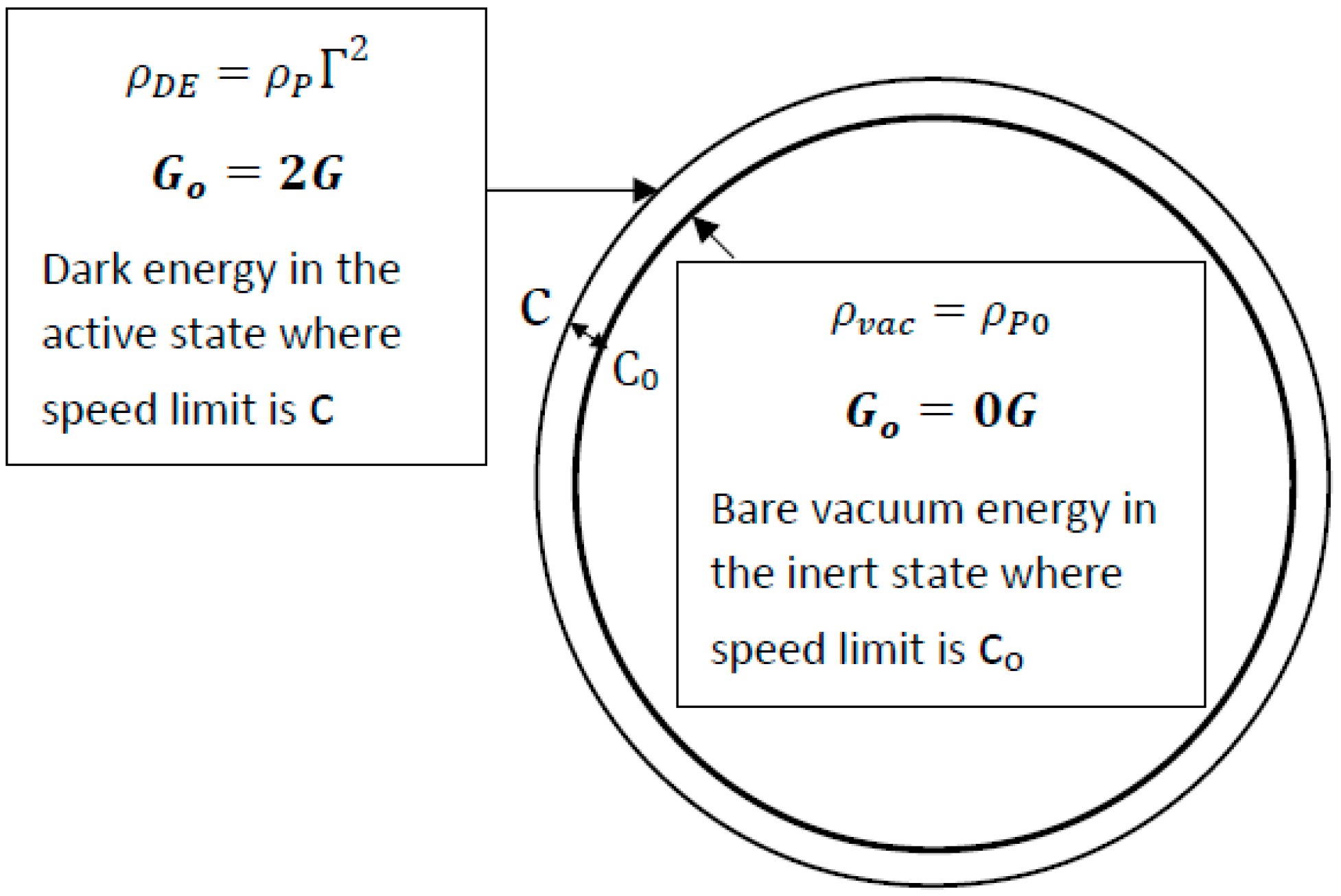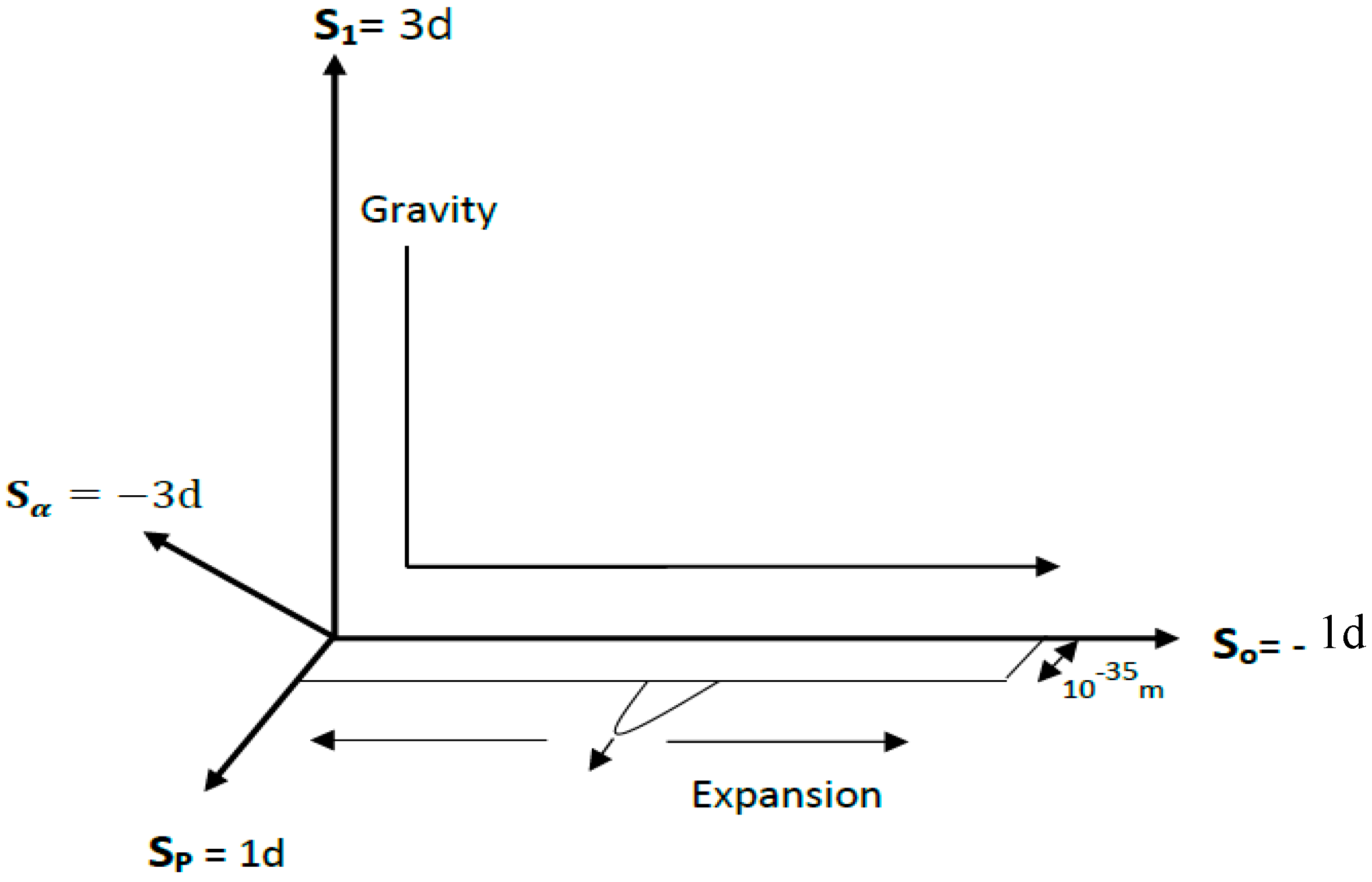1. Introduction
Dark energy is a mysterious energy component that has been observed to be driving the accelerated expansion of the universe, and have defied several explanations since its discovery in supernova observations, first reported in 1998 [
1]. Its existence has since been confirmed by several independent observations like the Planck measurements of the Cosmic Microwave Background (CMB), indicating that it accounts for about 68.3% [
2] of the gravitating energy content of the universe. This is in addition to the older dark matter mystery of gravitationally attractive but invisible energy component constituting about 26.8% of the gravitating energy content of the universe. Only about 4.6% is in the form of visible baryonic matter.
The cosmological constant (Λ) earlier introduced into Einstein’s Field Equations, while being the simplest solution, results in a conflict between measured density of dark energy and the 120 orders of magnitude larger value predicted from quantum field theory [
3]. The Λ problem has defied logical solution from supersymmetric cancellation approach, relaxation of vacuum energy [
4] and anthropic approaches [
5]. It also defies an approach that simply makes the spacetime metric insensitive to Λ [
6].
Slowly evolving scalar field models like Quintessence, is one of the prominent alternative approaches to solve the dark energy mystery without the Λ route. We also have modified gravity models and unification of dark energy and dark matter. See Ref. [
7] for detailed review and Refs. [
8,
9] for recent review.
The amount of theoretical and observational efforts that has been applied to understand dark energy and dark matter shows that they require new physics beyond the existing standard model of cosmology and particle physics.
Attempts to resolve the dark matter mystery can be mainly classified as either a modification of gravity or introduction of new particles beyond the standard model of particle physics. However, both approaches of modified gravity and particle dark matter have failed to provide consistent explanations to the dark matter mystery even though each approach tends to explain some observations and fail at some others.
There is an approach that explains dark matter as gravitational polarization of vacuum energy by baryonic matter without invoking new particle or modifying gravity in the traditional sense [
10]. It is based on the idea that matter and antimatter have opposite gravitational charges which requires a violation of the Weak Equivalence Principle. Preliminary findings from measurements of antiproton to proton charge to mass ratio implies that matter and antimatter gravitate the same way up to 97% accuracy [
11]. The ongoing AEgIS experiment at CERN [
12] should provide a definitive test for the Weak Equivalence Principle.
In this paper, the dark energy and dark matter puzzle are tackled using the framework of Extra Dimension Symmetry (EDS) that doubles the number of large extra dimensions with microscopic partners. EDS provides a solution to the dark energy puzzle by placing the bare vacuum energy component in a gravitationally inert state where the actual gravitational constant
Go= 0G. Due to a speed limit asymmetry and energy density constraint, a non zero component spills into the gravitationally active state where
Go= 2G, as dark energy. For dark matter, it relies on the background effect of neutrinos which induces a nonzero gravitational constant in the inert state, enabling the gravitation of virtual particles which appears as dark matter. This neutrino substrate approach for dark matter neither requires the polarization of the quantum vacuum nor opposite gravitational charges for particles and antiparticles like in [
10].
This paper is organized as follows.
Section 2 discusses the key dimensional symmetry that doubles the number of large spatial dimensions with microscopic partners. It also discusses the speed constraint, the two on and off gravitational states, their speed limit asymmetry and density constraint, which is then applied in section 4 to provide a solution the Λ problem of vacuum energy.
Section 3 discusses General Relativity in a large extra dimension and explores its unique features of gravitational inversion as well as the chain of causality in gravitation. It is shown that the expansion of a time-like spatial dimension is quantitatively equivalent to the curvature of our visible spatial dimensions.
Section 4 discusses the emergence of dark energy due to a speed limit asymmetry and energy density constraint discussed in section 2, while in section 5, the key reheating prediction is discussed.
Section 6 discusses the gravitation of virtual particles which appears as dark matter due to the background effect of neutrino substrates which induces nonzero gravitational constant in the inert state. Discussion and conclusion follows in
Section 7.
2. Extra Dimensional Symmetry Framework
In this framework, the number of large spatial dimensions is described by the dimension number
such that,
where
corresponds to
which is a time like spatial dimension that is invisible due to speed constraint discussed in
Section 2.1.
corresponds to which is our visible spatial dimensions.
The EDS framework doubles large spatial dimensions with microscopic dimensional partners with opposite dimension numbers such that the total dimension number of the universe is zero as illustrated in
Figure 1. While the dimensional partner of S
0, is a Planck size
dimension, the dimensional partner of S
1 is denoted
. If there is perfect symmetry,
. It is assumed that the large spatial dimensions S
1 and S
0 where inflated in the early universe at the expense of their dimensional partners
and S
P which contracted to their microscopic sizes becoming invisible.
In resolving the mysteries of dark energy and dark matter, this paper focuses on the S0 dimension and its microscopic dimensional partner SP as well as their interactions with the visible spatial dimension S1.
Figure 1.
Large spatial dimensions S
1 and S
0 and their microscopic dimensional partners
and S
P. Gravitational inversion symmetry implies that S
P and
were contracted to their minimum microscopic sizes to inflate S
0 and S
1 in the early universe. It is assumed that before then, they were all comparable in size. The gravitational inversion interaction is now between S
1 and S
0 as illustrated in
Figure 5, in section 3.1.
Figure 1.
Large spatial dimensions S
1 and S
0 and their microscopic dimensional partners
and S
P. Gravitational inversion symmetry implies that S
P and
were contracted to their minimum microscopic sizes to inflate S
0 and S
1 in the early universe. It is assumed that before then, they were all comparable in size. The gravitational inversion interaction is now between S
1 and S
0 as illustrated in
Figure 5, in section 3.1.
2.1. Speed constraint and invisibility of S0
Despite its cosmic size, the S
0 dimension is invisible due to its time like behavior from the speed constraint illustrated in Equation (2) and
Figure 2. The speed constraint requires that a particle’s velocity must always equal the maximum speed limit c in the S
1 – S
0 dimension. Massless particles like photons have zero velocity component along S
0, while massive particles and antiparticles travel in opposite directions along S
0. This motion along S
0 is quantitatively equivalent to the passage of time such that,
where
µ is particle velocity along S
0, and
ν is particle velocity along visible spatial dimension S
1.
Figure 2.
The speed constraint relationship between visible spatial dimensions S1 and time like spatial dimension S0.
Figure 2.
The speed constraint relationship between visible spatial dimensions S1 and time like spatial dimension S0.
When for massive particles, and conversely, when ν for massless particles, to satisfy the speed constraint.
This suggests that time can be an emergent temporal dimension driven by the velocity of a particle along S
0 dimension. How fast time appears to pass for a massive particle can be equivalent to the ratio of its S
0 component of velocity
to the speed limit c as,
where
is the equivalent Lorentz factor for the S
0 dimension
Since
2.2. Speed limit asymmetry
The asymmetry in speed limits c and c
0 is described by the asymmetry parameter
which is the ratio of the Planck size of S
P to the size of S
0 dimension and
such that,
where
is the size of S
0 in Planck unit. And
. where
, is the value of
in flat spacetime. The increase in size
is proportional to the absolute value of the gravitational potential
such that,
where
is a constant. We also have the following asymmetry relationship between the two speed limits which is also affected by the dynamics of
.
Figure 3.
Ring structure of S0 - SP dimensions with two unequal speed limit states C and C0, at the two ends of SP dimension. Traveling in opposite directions of S0 represents particle and antiparticle states. A net spin with respect to this time like dimension might cause baryon asymmetry.
Figure 3.
Ring structure of S0 - SP dimensions with two unequal speed limit states C and C0, at the two ends of SP dimension. Traveling in opposite directions of S0 represents particle and antiparticle states. A net spin with respect to this time like dimension might cause baryon asymmetry.
2.3. Gravitational state oscillation
In EDS, Standard Model particles oscillates between the two speed states which are also opposite gravitational on and off states. This is such that for a particle of energy E, with the exception of neutrinos, the state life time
for such particle is,
where
is the reduced Planck constant and
is the Planck energy. The oscillation of neutrinos between the active and the inert phase is regulated by a different mechanism.
The oscillation of Standard Model particles between the two gravitational states and , makes gravity discrete on microscopic spacetime scale. It however appears smooth on macroscopic spacetime scale with an average gravitational constant G.
2.4. Energy density constraint
The energy density constraint essentially constrains the total energy density in a given volume of spacetime to always equal the upper limit of the Planck density
. This is only obtainable in the gravitational active state where the speed limit is c while the bare vacuum energy component exists in the inert state with lower speed limit and hence lower Planck density
where
is the vacuum energy density, and
is the total baryonic matter density. The key significance of this, is in the emergence of non zero Λ dark energy in section 4. However, such energy density constraint implies a Planck density limit to the density of black holes like that suggested in [
13], where Planck stars replaces black hole singularities.
3. General Relativity in S0 dimension
Solution of Einstein’s Field Equations in 1+1 dimensionality is being used as a pedagogical tool [
14] and reveals some interesting properties of the equations in such dimensionality.
In this section, the focus is on General Relativity in -1+1 dimension which has some inverted features not seen 1+1 dimensionality because of the negative dimension number of S
0. The negative dimension number of the S
0 dimension gives it some features such as appearance of positive energy density as negative energy density and the inversion of positive pressure to negative pressure. Eintein’s Field Equations in S
0 can be expressed as
where
is the equivalent Einstein Tensor in S
0 dimension.
is the equivalent cosmological constant and
is the stress energy tensor as seen in S
0 dimension.
In -1+1 dimensionality, just as in 1+1, the curvature term
is zero, and Equation (11) becomes
3.1. Features of General Relativity in S0 dimension
The negative one dimensionality of S0 confers on it some unique features such as:
- i.
Positive energy density in S1 is equivalent to negative energy density everywhere in S0.
An energy density associated with a given Planck volume of 3d space S
1 appears as an equivalent negative energy density everywhere along S
0 dimension associated with it as a positive cosmological constant as illustrated in
Figure 4.
- ii.
Positive pressure in S1 is equivalent to negative pressure in S0
Any form of positive pressure in S1 appears as negative pressure in S0 for the same reason of negative dimensionality. The result is a positive cosmological constant expansion of S0.
- iii.
Negative pressure in S1 is equivalent to a positive pressure in S0
The same negative dimensionality causes the inversion of negative pressure in S
1 appearing as positive pressure in S
0 driving its negative cosmological constant contraction. The result is that the curvature of S
1 (
) is equivalent to the cosmological constant expansion of S
0 as illustrated in
Figure 5, such that,
and a positive cosmological constant term (
) in S
1 is equivalent to a negative cosmological constant term (
) in S
0 such that,
Figure 4.
A gravitational well in S1 is inverted into a gravitational hill with the expansion of S0 by a test particle. The test particle is replicated over 1060 times everywhere along S0 dimension.
Figure 4.
A gravitational well in S1 is inverted into a gravitational hill with the expansion of S0 by a test particle. The test particle is replicated over 1060 times everywhere along S0 dimension.
Figure 5.
Gravitational inversion. A positive cosmological constant expansion of S0 is equivalent to curvature of S1. Also, a negative cosmological constant contraction of S0 is equivalent to a positive cosmological constant expansion of S1.
Figure 5.
Gravitational inversion. A positive cosmological constant expansion of S0 is equivalent to curvature of S1. Also, a negative cosmological constant contraction of S0 is equivalent to a positive cosmological constant expansion of S1.
3.2. Gravitational chain of causality
The inversion of gravitation discussed in the previous section suggests that at a more fundamental level, gravity is the expansion or contraction of S
0 dimension. This then manifests in an inverted form as curvature or expansion of S
1 dimension as illustrated in
Figure 5 and
Figure 6. The existence of gravitational on and off states acts as a filter in this gravitational chain of causality enabling real particles to gravitate while virtual particles remain inert.
Figure 6.
Gravitational chain of causality. Gravity at a more fundamental level is about expansion or contraction of S0 which manifests invertedly in S1 as curvature or expansion respectively. Also gravitation of particles depends on if they are in a gravitationally active or inert state.
Figure 6.
Gravitational chain of causality. Gravity at a more fundamental level is about expansion or contraction of S0 which manifests invertedly in S1 as curvature or expansion respectively. Also gravitation of particles depends on if they are in a gravitationally active or inert state.
The relatively permanent existence of the bare vacuum energy component in the gravitationally inert state ensures that it does not gravitate. This partly solves the cosmological constant problem. The second part of the problem about the nonzero value is addressed in the next section.
4. Emergence of nonzero Cosmological Constant
The asymmetry in speed limit described in Equation (8) between the two gravitational states also reflects in the values of their Planck densities such that
where
is the lower Planck density in C
0 state and
is the Planck density in the C state.
The existence of the bare vacuum energy component
in the lower C
0 state implies that
which is less than the Planck density and the energy density constraint requires that the total vacuum energy density should be equal to the Planck density in the absence of matter.
Since the gravitationally inert lower speed state lacks the capacity to contain all the vacuum energy components, a small component spills into the gravitationally active state as dark energy.
Figure 7.
While the bare vacuum energy component occupy the gravitationally inert state C0 to its limit, there has to be a component in the gravitationally active state C to satisfy the energy density constraint so that the total vacuum energy density equals the Planck density . The lower Planck density is associated with speed state C0.
Figure 7.
While the bare vacuum energy component occupy the gravitationally inert state C0 to its limit, there has to be a component in the gravitationally active state C to satisfy the energy density constraint so that the total vacuum energy density equals the Planck density . The lower Planck density is associated with speed state C0.
Since
is suppressed with the expansion of S
0 in the gravitational well of massive objects (Equation (6) and
Figure 4), the density of this form of dark energy varies spatially according to this suppression by gravitational potential wells. The deeper the gravitational well the more the suppression. And substituting the value of
from Equation (6),
where
is the size of S
0 dimension in Planck unit, which increases with the absolute value of the gravitational potential
according to Equation (7).
5. Gravitational Wave Reheating (GWR) Prediction
The propagation of gravitational waves along the visible 3d space S
1 should also vibrate any extra spatial dimension such as the S
P and S
0 dimensions. The stretching of S
P dimension during such vibration should cause the creation of real photons out of vacuum energy. This is the Gravitational Wave Reheating (GWR) mechanism of EDS. However as illustrated in
Figure 8, the expansion of S
0 dimension in gravitational potential wells suppresses the possible stretching of S
P dimension resulting in a threshold value of strain
below which reheating cannot occur.
Figure 8.
The expansion of the S0 dimension in gravitational potential wells, suppresses the possible stretching of SP dimension by gravitational waves oscillations.
Figure 8.
The expansion of the S0 dimension in gravitational potential wells, suppresses the possible stretching of SP dimension by gravitational waves oscillations.
This is such that for reheating to occur, the gravitational wave strain
must be greater than the gravitational strain
of S
0 expansion
and
where
is the increase in the size of S
0 dimension and it is proportional to the absolute value of the gravitational potential
from Equation (7).
is the size of S
0 in flat spacetime.
hardens the S
P dimension against gravitational wave oscillation.
5.1. Energy scale of reheat photons
The maximum energy
of the reheat photons that can be emitted in the resulting spectrum can be described by
where
is the Planck energy and
is the effective stretching strain of the resulting S
P oscillation once the threshold gravitational wave strain is exceeded such that
.
5.2. Magnetic softening of the SP dimension
Magnetic fields produce negative pressure that can flatten curvature and even dampen gravitational waves [
15]. Within the EDS framework, the gravitational strain of expansion (
) of the S
0 dimension is a measure of spatial curvature. Therefore, the flattening of spacetime curvature softens the S
P dimension which becomes more sensitive to gravitational wave oscillation. In essence, a strong magnetic field like that obtainable around magnetars, softens the S
P dimension by lowering the threshold strain required for reheating to occur with incident gravitational waves.
From energy conservation perspective, the energy lost by gravitational waves passing through a strongly magnetized region has to be released in some form and GWR provides the mechanism for converting the gravitational wave energy into electromagnetic one. It is expected that the brief burst of electromagnetic waves radiated while the gravitational waves passes through a strongly magnetized region such as magnetars, should be in the form of radio waves.
6. Dark Matter from Vacuum Energy
The bare vacuum energy component should always be gravitationally inert with its existence in the
state where the gravitational field is effectively swiched off. However, in this framework, neutrinos affects their background in the inert state such that
. Within such background in the inert state, neutrinos provide some gravitational illumination described by Equation (22) that enables virtual particles to gravitate with positive pressure appearing as dark matter.
where
is the neutrino induced gravitational constant in the inert state.
is the asymmetry parameter involved in the emergence of dark energy.
is the flavour parameter. It varies with neutrino flavour such that
.
is a dimensionless phase parameter that varies between zero and one (
), with zero being a ground phase where it always gets stuck until it experiences a disturbance of the microscopic dimensions such as reheating described in the previous section. It remains in this active phase for a life time
and falls back to the
phase.
is a dimesionless parameter that varies with neutrino kinetic energy.
and it is described by,
where
is the neutrino kinetic energy and
is the Planck energy. Substituting
from Equation (6), Equation (22) becomes,
where
is the size of the S
0 dimension (in Planck unit) which increases with the absolute value of the gravitational potential
, hence the suppression of dark matter effect of neutrinos in deep gravitational potential wells.
While hot dark matter is the form of dark matter that can be produced by relativistic neutrinos, cosmic neutrinos are nonrelativistic. Such nonrelativistic cosmic neutrino substrates should be further slowed down by the Higgs like drag from its self induced gravitational interaction with virtual particles within its background. This enhances the clustering of cosmic neutrino substrates and the gravitating virtual particles in their background appear as cold dark matter.
The gravitational potential suppression of
enables this substrate dependent form of dark matter to have hybrid behaviour by mimicking modified gravity form of dark matter such as Modified Newtonian Dynamics (MOND) while also exhibiting some particle behavior of its neutrino substrates like the gravitational polarization of vacuum energy approach [
13] and superfluid dark matter described in [
16].
6.1. Categories of neutrino substrate dependent dark matter
Heavy and light dark matter are two categories of neutrino substrate dependent dark matter that exists within the EDS frame work depending on the neutrino energy scale and phase parameter. Equation (22) consist of a rest term and a kinetic term . The kinetic term can be active or inert depending on the phase parameter which varies between one and zero where it freezes. can be unfrozen from zero, activating the kinetic term, by the reheating mechanism discussed in section 5 and falls back to its frozen phase within a life time .
- i.
Heavy dark matter
From Equation (22), an Ultra High Energy neutrino with a kinetic energy of 1015 eV and a phase parameter , will have an active kinetic term. It can induce a gravitational constant close to 10-13 G in the gravitationally inert state where the bare vacuum energy exists. With the gravitation of vacuum energy of the order the Planck density, it can manifest as detectable heavy dark matter with an equivalent gravitational parameter of a microscopic black hole with mass of a small asteroid outside the deep gravitational potential wells of planets and stars. As the high energy neutrino substrate falls back to the frozen phase with the kinetic term becomes inactive, making it become light form of dark matter. A micro-resolution digital scale should have the sensitivity to detect the gravitational effect of such heavy dark matter while it is still active, which should mostly happen outside the deep gravitational well of the planet.
- ii.
Light dark matter
Neutrinos in the state, particularly cosmic neutrinos can induce close to 10-120 G in the gravitationally inert state, resulting in light and cold dark matter, clustered within and around galaxies. Such light form of dark matter which dominates the total dark matter density in this framework, can only be detected through the CMB, gravitational lensing and the dynamics of wide stellar binaries, galactic and extra galactic structures.
7. Discussion and Conclusion
EDS provides an elegant framework for the resolution of the cosmological constant problem of dark energy and the nature of dark matter. In doing so it provides deeper insights into the dimensional structure of spacetime and chain of causality involved in gravitation. Specifically, it places the bare vacuum energy component in a state where the gravitational field is switched off with actual gravitational constant G0 = 0G, while real standard model particles, oscillate between this gravitationally inert state and the active state.
Due to an energy density constraint and a speed limit asymmetry that limits the capacity of the inert state to contain all the vacuum energy component, a small component spills into the active state as dark energy. The asymmetry parameter is the ratio of the size of the spatial equivalent of time (S0 dimension) and its microscopic partner SP.
The illuminating effect of neutrino substrates particularly cosmic neutrinos, induces non zero gravitational constant in the inert state, providing gravitation for virtual particles which appears as dark matter. This neutrino substrate dependent form of dark matter can exhibit a hybrid behaviour of particle dark matter and modified gravity form of dark matter like the gravitational polarization of vacuum energy approach [
13] and superfluid dark matter [
16]. The heavy form of dark matter that can be activated by the gravitational disturbance of the microscopic dimension S
P, provides an opportunity for direct detection of such form of dark matter while it is active.
The reheating prediction in which gravitational waves produce electromagnetic secondary with negative pressure from strong magnetic fields of magnetars and dark energy might be the sources of Fast Radio Bursts (FRBs) [
17] and Excess Radio Background (ERB) [
18].
Expected results from the trio of the JWST, Euclid and upcoming Nancy Grace Roman Telescope and Vera Rubin Observatory, are expected to provide precision measurements of dark energy density as well as the dynamics of dark matter. Such precision measurements should glean out the predicted suppression of dark energy density in the deep gravitational potential wells of baryonic matter like it apparently does to dark matter.
There are a number of potential insights that are beyond the scope of this paper. For instance it is possible that the fine structure constant just like
, is simply the ratio of the Planck scale to the size of the
dimension. It is also possible that the rest term in Equation (24), might be the source of neutrino mass. These possibilities as well as others like baryon asymmetry from net spin with respect to the S
0 dimension (
Figure 3), shall be investigated in future work.
In conclusion, the EDS framework offers new physics explanations for dark energy and dark matter as different manifestations of vacuum energy that can be tested and provides potential insights into the dimensional structure of spacetime and gravity.
Author Contributions
Kabir Adinoyi Umar: Conceptualization, Investigation, Writing-original draft, Writing-review and editing, Resources. Benjamin Gbenga Ayatunji: Supervision.
Data availability
No data was used for the research described in the article
Acknowledgments
The author gratefully acknowledge Benjamin G. Ayatunji for his criticisms, encouragement and mentorship and S. X. K. Howusu for his inspiring advice and initial motivation for this work. This work was funded by the author.
Declaration of competing interest
The authors declare that they have no known competing financial interests or personal relationships that could have appeared to influence the work reported in this paper.
References
- Riess, A. G. et al., Observational evidence from supernovae for an accelerating universe and a cosmological constant, Astron. J. 116 (1998) 1009-1038, arXiv: astro-ph/9805201. [CrossRef]
- Ade P. A. R. et al., Planck 2013 results. XVI. cosmological parameters, (2013), arXiv:1303.5076[astro-ph.CO].
- Carroll, S. M., The cosmological constant, Living Rev. Rel. 4:1, (2001), arXiv:astro-ph/0004075.
- Kachru, S. et al., de Sitter vacua in string theory, Phys. Rev. D68 (2003) 046005, arXiv:hep-th/0301240.
- Banks, T. et al., On anthropic solutions of the cosmological constant problem, JHEP 0101 (2001) 031, arXiv:hep-th/0007206. [CrossRef]
- Arkani-Hamid, N., A small cosmological constant from a large extra dimension, Phys. Lett. B480 (2000) 193-199, arXiv:hep-th/000197.
- Copeland, E. J. et al., Dynamics of dark energy, Int. J. Mod. Phys. D15 (2006) 1753-1936, arXiv:hep-th/0603057.
- Oks E., Brief review of recent advances in understanding dark matter and dark energy, New Astron. Rev. 93 (2021) 101632, arXiv:2111.00363[astro-ph.CO]. [CrossRef]
- Arun K. et al., Dark matter, dark energy and alternate models: a review, Advances in Space Research, 60, (2017) 166-186, arXiv: 1704.06155[physics.gen-ph].
- Hajdukovic D. S., Quantum vacuum and dark matter, Astrophysics and Space Science 337 (2012)9-14.
- Borchert M. J., Devlin J. A., Ulmer S., et al., A 16 parts per trillion measurement of the antiproton to proton charge-mass ratio, Nature 601 (2022) 53-57.
- Huck S. et al., Toward a pulsed antihydrogen beam for WEP test in AEgIS, EPJ Web of Conf. 282 (2023) 01005.
- Rovelli, C., Vidoto, F., Planck Stars, Int. J. Mod. Phys. D23 (2014) 1442026, arXiv:1401.6562.
- Boozer A. D., General relativity in (1+1) dimension, Eur. J. Phys. 29 (2008) 319-333. [CrossRef]
- Tsagas C. G., Magnetic tension and the geometry of the universe, Phys. Rev. Lett. 86 (2001) 5421. [CrossRef]
- Hossenfelder S., Mistele T., The Milky Way’s rotation curve with superfluid dark matter, MNRAS 498 (2020) 3484-349, arXiv:2003.07324[astro-ph.GA]. [CrossRef]
- Zhang B., The Physics of Fast Radio Bursts, (2022), arXiv:2212.03972[astro-ph.HE]. [CrossRef]
- Fialkov A., Barkana R., Signature of Excess Radio Background in the 21-cm global signal and power spectrum, (2019), arXiv: 1902.02438[astro-ph.CO]. [CrossRef]
|
Disclaimer/Publisher’s Note: The statements, opinions and data contained in all publications are solely those of the individual author(s) and contributor(s) and not of MDPI and/or the editor(s). MDPI and/or the editor(s) disclaim responsibility for any injury to people or property resulting from any ideas, methods, instructions or products referred to in the content. |
© 2023 by the authors. Licensee MDPI, Basel, Switzerland. This article is an open access article distributed under the terms and conditions of the Creative Commons Attribution (CC BY) license (http://creativecommons.org/licenses/by/4.0/).
